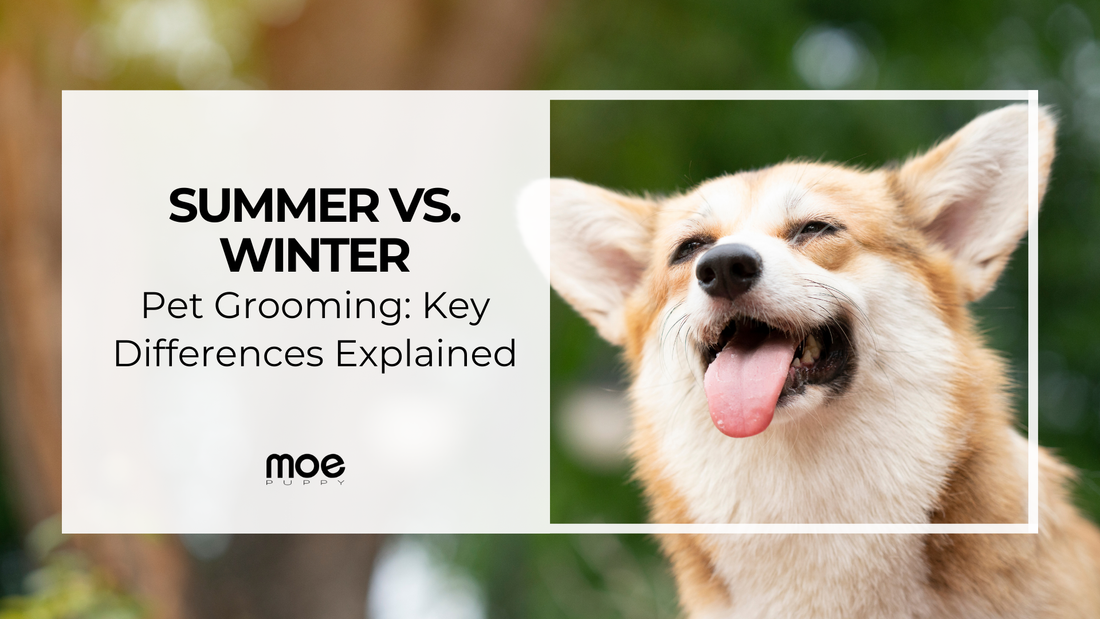
Summer vs. Winter Pet Grooming: Key Differences Explained
Share
Grooming is an essential part of pet care, ensuring that your furry friend remains comfortable and healthy throughout the year. However, pet grooming needs change drastically between summer and winter due to variations in temperature, humidity, and seasonal challenges. Understanding these differences can help pet parents provide the right care tailored to each season.
Summer Pet Grooming: Keeping Pets Cool and Comfortable

1. Coat Maintenance and Shedding
During the summer, many pets experience increased shedding as their bodies naturally adjust to warmer temperatures. Regular brushing is crucial to remove loose fur, reduce matting, and improve air circulation around the skin. Short-haired breeds may shed more heavily, while double-coated breeds require special attention to prevent overheating.
Key Tips:
- Brush your pet daily to remove loose fur and minimize heat retention.
- For long-haired breeds, consider light trims but avoid shaving, as their coat provides insulation against heat and sunburn.
- Use high-quality grooming tools like deshedding brushes and undercoat rakes to manage excessive shedding.
2. Bathing and Skin Care
Hot and humid conditions can make pets more prone to skin infections, itchiness, and allergies. Frequent outdoor activities expose them to dust, pollen, and other irritants, making regular baths a necessity.
Key Tips:
- Use a mild, pet-friendly dog shampoo like our Xtra Nourish Shampoo at to cleanse your pet’s skin without stripping natural oils.
- Bathe your pet every two to four weeks, depending on their activity level and breed.
- Ensure thorough drying, especially for thick-coated breeds, to prevent bacterial or fungal growth.
3. Paw and Nail Care
The summer heat can make asphalt and pavement extremely hot, leading to burned paw pads. Trimming nails is also essential since long nails can cause discomfort and make walking difficult.
Key Tips:
- Walk pets during cooler hours, such as early morning or late evening.
- Apply a pet-safe paw cream for dogs to protect pads from hot surfaces.
- Regularly trim nails to maintain proper foot health and prevent joint stress.
4. Ear and Eye Care
Increased outdoor exposure in summer can lead to ear infections, especially in breeds with floppy ears, as heat and humidity create an ideal environment for bacterial growth.
Key Tips:
- Clean your pet’s ears with a gentle, pet-safe dog ear cleaning solution to prevent infections.
- Check for signs of redness, excessive wax buildup, or foul odor.
- Keep the eye area clean to prevent irritation from dust and pollen.
5. Hydration and Coat Conditioning
Pets tend to dehydrate quickly in summer, affecting their coat’s health and overall well-being. Dry skin and excessive shedding can be prevented with proper hydration and coat conditioning.
Key Tips:
- Ensure your pet has access to clean, fresh water at all times.
- Use a moisturizing best dog conditioner Like 4 in 1 Conditioner to keep the coat soft and hydrated.
- Consider adding omega-3 and omega-6 fatty acids to their diet to promote a healthy coat.
Winter Pet Grooming: Keeping Pets Warm and Protected

1. Coat Maintenance and Shedding
While pets shed less in winter, their coat thickens to provide warmth. Brushing remains essential to prevent matting, which can reduce insulation efficiency and cause skin issues.
Key Tips:
- Brush regularly to remove loose fur and maintain proper air circulation within the coat.
- Avoid excessive trimming, as the natural coat acts as insulation.
- Use Deodorizer+detangler to Detangle the fur and keep it fresh
2. Bathing and Skin Care
Cold air and indoor heating can lead to dry, flaky skin. Overbathing can strip natural oils, worsening dryness and irritation.
Key Tips:
- Reduce bath frequency to once every four to six weeks.
- Use a hydrating dog conditioner shampoo from Moe Puppy to prevent dryness.
- Apply a pet-safe moisturizer to keep the skin healthy.
3. Paw and Nail Care
Winter presents new challenges for paw care, such as exposure to ice, salt, and cold surfaces. Dry and cracked paw pads are common, requiring extra protection.
Key Tips:
- Apply a protective dog paw cream before walks to prevent cracking and irritation.
- Rinse and dry paws thoroughly after walks to remove salt and chemicals.
- Keep nails trimmed to ensure good traction on slippery surfaces.
4. Ear and Eye Care
Cold winds and dry air can lead to increased tear production or irritation in pets. Additionally, pets spending more time indoors can develop wax buildup in their ears.
Key Tips:
- Regularly clean your pet’s ears to prevent infections using a dog ear cleaning solution.
- Monitor for signs of irritation, especially in breeds prone to eye discharge.
- Keep the eye area clean to avoid tear stains and debris buildup.
5. Hydration and Coat Conditioning
Even in winter, hydration is crucial for maintaining a healthy coat and skin. Many pets drink less water in colder months, leading to dry skin and dull fur.
Key Tips:
- Encourage hydration by offering warm water or incorporating moisture-rich foods into meals.
- Use a nourishing best dog conditioner from Moe Puppy to retain moisture and prevent static.
- Provide omega fatty acid supplements to maintain coat shine and health.
Final Thoughts
Seasonal grooming adjustments ensure your pet remains comfortable and healthy all year round. While summer grooming focuses on cooling, shedding control, and skin protection, winter grooming prioritizes insulation, hydration, and paw care. By using high-quality grooming products from Moe Puppy and following these expert tips, you can keep your pet looking and feeling their best regardless of the season

